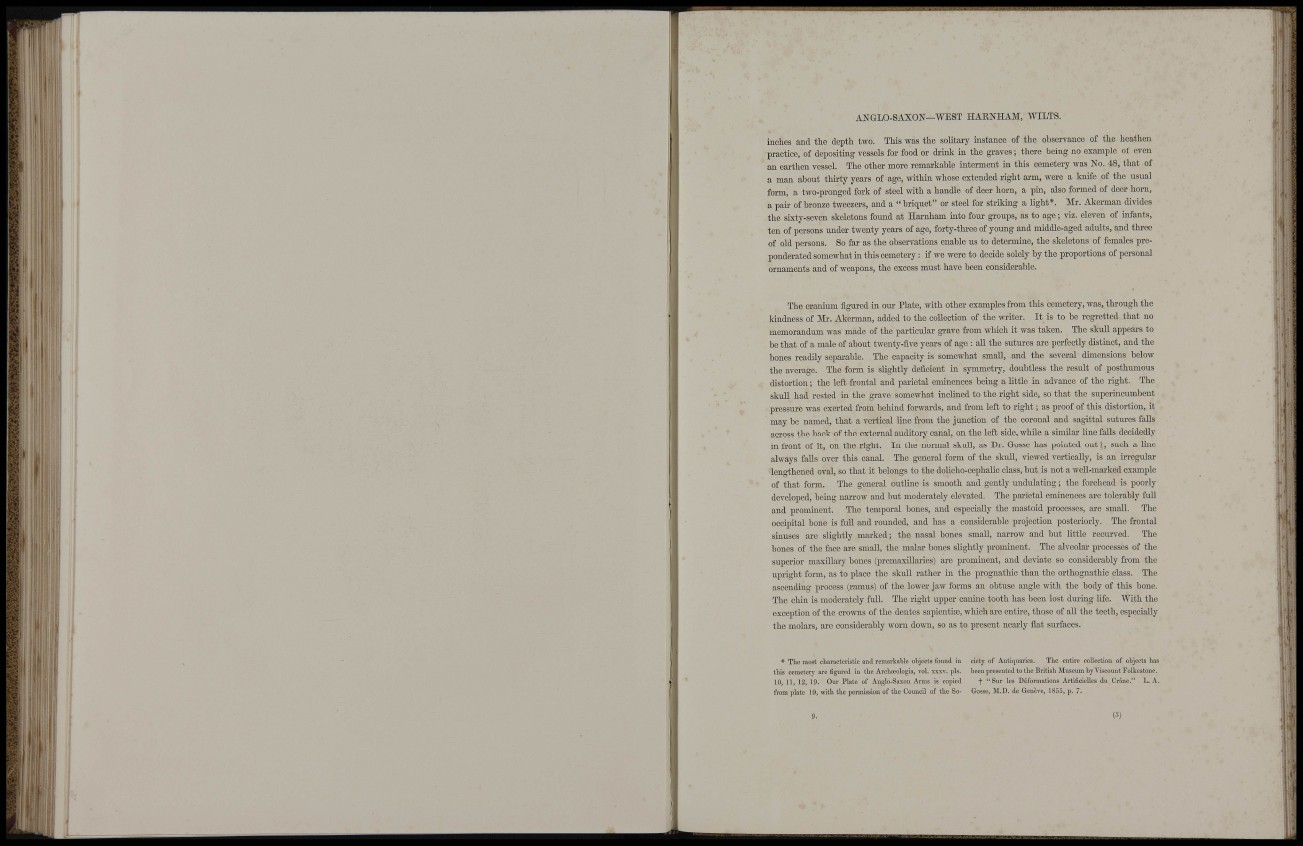
1 - r
. llNIIH
l e i;:
ANGLO-SAXON—WEST HARNHAM, WILTS.
inches and the depth two. This was the solitary instance of the observance of the heathen
practice, of depositing vessels for food or drink in the graves; there being no example of even
an earthen vessel. The other more remarkable interment in this cemetery was No. 48, that of
a man about thirty years of age, within whose extended right arm, were a knife of the usual
form, a two-pronged fork of steel with a handle of deer horn, a pin, also formed of deer horn,
a pair of bronze tweezers, and a " briquet" or steel for striking a hght*. Mr. Akerman divides
the sixty-seven skeletons found at Harnham into four groups, as to age; viz. eleven of infants,
ten of persons under twenty years of age, forty-three of young and middle-aged adults, and three
of old persons. So far as the observations enable us to determine, the skeletons of females preponderated
somewhat ia this cemetery: if we were to decide solely by the proportions of personal
ornaments and of weapons, the excess must have been considerable.
9. (3)
'
1
The cranium figured in our Plate, with other examples from this cemetery, was, through the
kindness of Mi'. Akerman, added to the collection of the writer. It is to be regretted that no
memorandum was made of the particular grave from which it was taken. The skuR appears to
be that of a male of about twenty-five years of age : aU the sutui-es are perfectly distinct, and the
bones readily sepai-able. The capacity is somewhat small, and the several dimensions below
the average. The form is slightly deficient in symmetry, doubtless the result of posthumous
distortion; the left frontal and parietal eminences being a little in advance of the right. The
skuU had rested in the grave somewhat inclined to the right side, so that the superincumbent
pressure was exerted from behind forwards, and from left to right; as proof of this distortion, it
may be named, that a vertical line from the junction of the coronal and sagittal sutures falls
across the back of the external auditory canal, on the left side, while a similar line falls decidedly
in front of it, on the right. In the normal skull, as Dr. Gosse has pointed outf, such a line
always falls over this canal. The general form of the skull, viewed vertically, is an irregular
lengthened oval, so that it belongs to the dolicho-cephalic class, but is not a well-marked example
of that form. The general outline is smooth and gently undulating; the forehead is poorly
developed, being narrow and but moderately elevated. The parietal eminences are tolerably fuU
and prominent. The temporal bones, and especially the mastoid processes, are small. The
occipital bone is full and rounded, and has a considerable projection posteriorly. The frontal
sinuses are slightly marked; the nasal bones small, narrow and but little recurved. The
bones of the face are small, the malar bones slightly prominent. The alveolar processes of the
superior maxillary bones (premaxiUaries) are prominent, and deviate so considerably from the
upright form, as to place the skull rather in the prognatMc than the orthognathic class. The
ascending process (ramus) of the lower jaw forms an obtuse angle with the body of this bone.
The chin is moderately full. The right upper canine tooth has been lost dm'ing life. With the
exception of the crowns of the dentes sapientise, which are entn-e, those of all the teeth, especially
the molars, are considerably worn down, so as to present nearly flat siu-faces.
* The most characteristic and remarkable objects found in
this cemetery are figured in the ArchiEologia, Tol. xxxv. pis.
10, 11, 12, 19. Our Plate of Anglo-Saxon Arms is copied
from plate 10, with the permission of the Council of the Society
of Antiquaries. The entire collection of objects has
been presented to the British Museum by Viscount Folkestone.
-f- " Sur les Déformations Artificielles du Crâne." L. A.
Gosse, M.D. de Genève, 1855, p. 7.
It' ! i
fi
1!
i 1 (
il